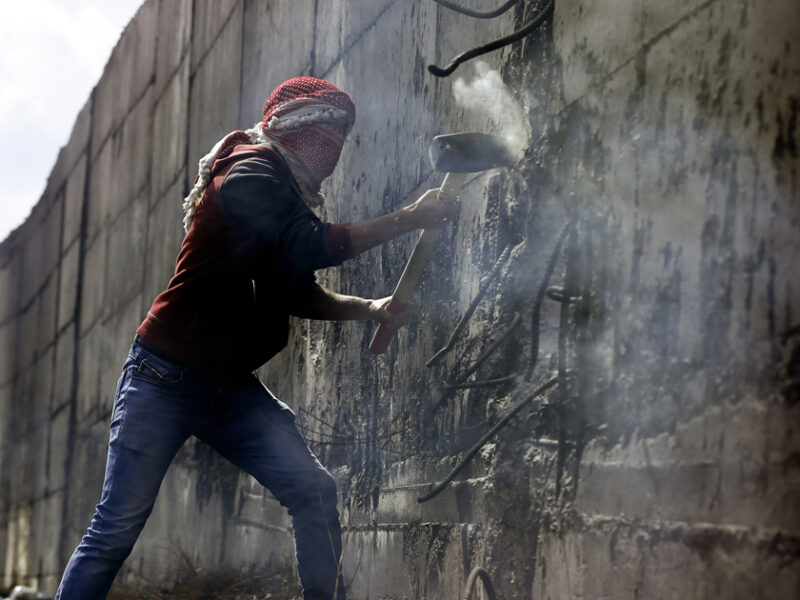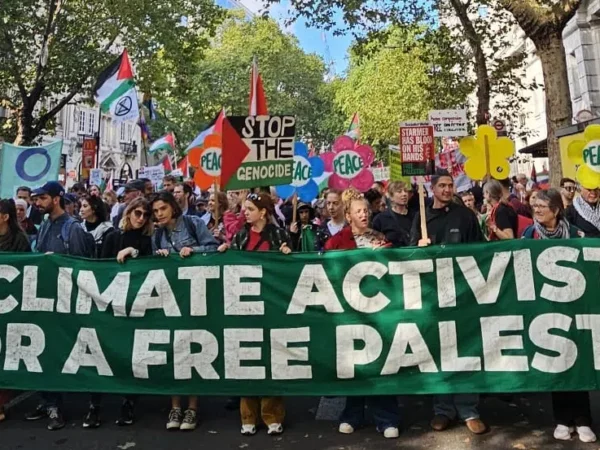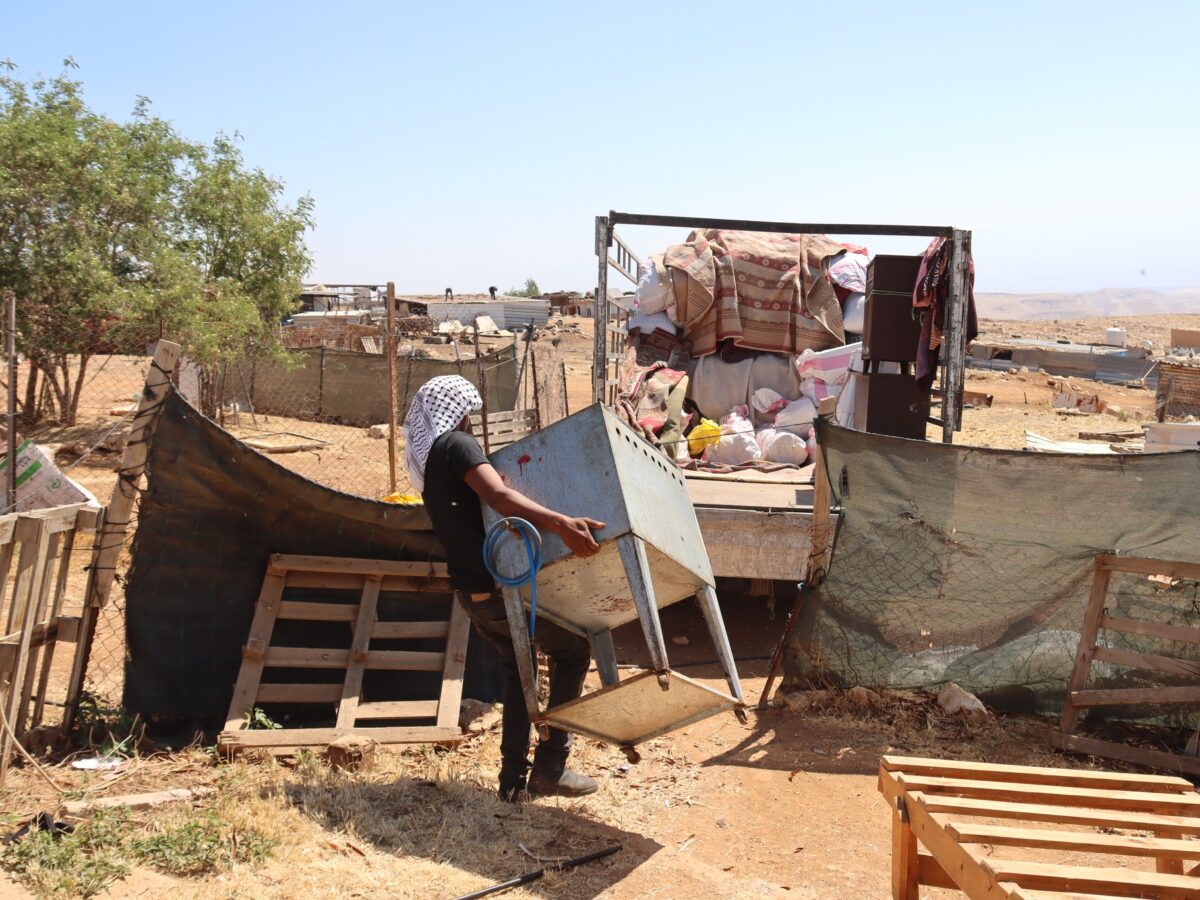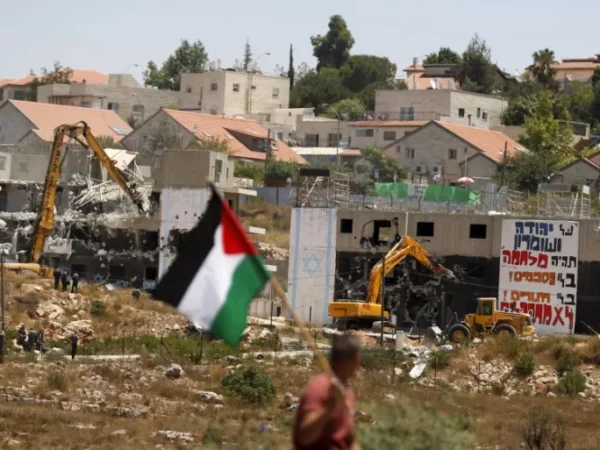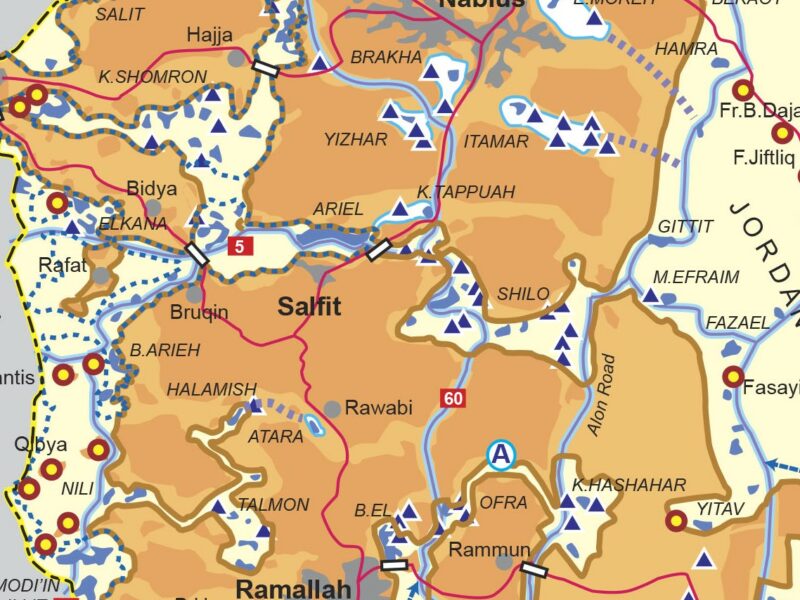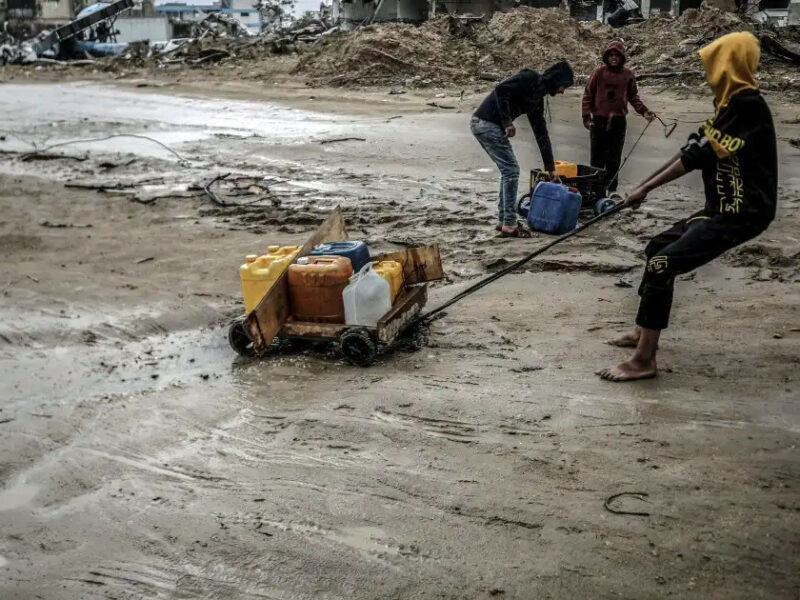THE WALL
The Wall’s construction started in 2002 to advance Israel’s annexation policies and to refine its apartheid regime over the Palestinian people. It does not surround the occupied West Bank but rather cuts deep into the occupied territory, expanding Israel’s theft of Palestinian land and resources.
Annexation
While Israel is heading for de jure annexation, the Wall is an important tool of Israel’s illegal and ongoing de facto annexation. The Wall’s path and its associated regime are planned to de facto annex some 46% of the West Bank, isolating communities into Bantustans, ghettos and “military zones.”
The International Court of Justice in its 2004 ruling on the illegality of Israel’s Wall in the occupied West Bank stated that “the Court considers the construction of the wall and its associated régime create a “fait accompli” on the ground that could become permanent, in which case, and notwithstanding the formal characterization of the wall by Israel, it would be tantamount to de facto annexation.“
The boundaries of annexation proposed by Trump’s ‘Deal of the Century’ overlap largely with the Wall’s path, further underscoring that the Wall has already created the reality of annexation. Eventually, the Palestinian population is to be forced out of these areas.
98% of the Israeli settler population of the West Bank will be included in the de facto annexed areas.
For more, see Stop the Wall’s Annexation map and explainer.
Apartheid
Israel’s Walls aim to enclose the Palestinian population in the West Bank and Gaza Strip, including almost 1.5 million refugees, on only 12% of their historic homeland.
The Wall literally cements the existence of segregated reserves and ghettos for Palestinians, one of the elements defining the crime of apartheid. These bantustans mirror both the structure used by the South African apartheid regime to relegate the Black population into unsustainable, segregated areas, and the confinement of Indigenous peoples to isolated reservations by other settler colonial states, which also served as the model for the development of the bantustan system.
The apartheid Wall is complemented by a complicated, roughly 1,660 km long system of ‘apartheid roads’ in the West Bank that systematically destroy the Palestinian road network while imposing a different road network for Israelis that Palestinians from the West Bank are not allowed to access. Learn more.
The illegality of the Wall
On July 9, the International Court of Justice (ICJ) in its Advisory Opinion on the legal consequences of the Wall has confirmed the Wall in the West Bank illegal and has called for Israel to dismantle it together with its associated regime. It found that by constructing the Wall, Israel is in breach of the prohibition on the acquisition of territory by force and the right to self-determination of the Palestinian people. These are peremptory norms that are binding on all States and from which no exceptions are permitted.
Hence the Court ruled that Israel’s violation of these norms as well as international humanitarian law, result in legal obligations for all States and the United Nations. The ICJ confirmed the obligation of the international community not to aid or assist in the implementation of Israel’s construction of the Wall and its associated regime or the maintenance of it. It has reminded the international community of its duty to take appropriate action to ensure to end this illegal situation.
10 years after the ICJ Advisory Opinion was released, 92 top legal experts and 41 legal networks have released a joint analysis “Time for Concrete Action” on the legal implications of the Wall and the ICJ decision and have urged UN and third-state to take action. Click here for more.
Expulsion – the ongoing Nakba
Some 12% of Palestinians in the West Bank are living in the closed military zones of the Jordan Valley surrounded by Israeli illegal settlements and military camps.
Thousands live in villages and towns designated as ‘seam zones.’. Seam zones are areas where Palestinians are stuck between the Apartheid Wall and the Green Line. In “Palestinian Towns And Villages: Between Isolation And Expulsion” we detail how these Palestinians face increasingly unbearable living conditions – the loss of land, markets, movement and livelihoods – and many face expulsion.
The seam zones impact the residents of the isolated areas as well as other Palestinians who are denied access to them, causing Palestinians to be totally fragmented from each other. Moreover, when agricultural lands fall within the seam zone areas, farmers residing outside these areas can rarely access their lands.
The Wall has destroyed a large amount of Palestinian farmland and usurped water supplies, including the largest aquifer in the West Bank.
Over 200,000 Palestinians of East Jerusalem are totally isolated from the rest of the West Bank and facing continuous efforts by the Israeli occupation authorities to drive them out of their city.
The Jordan Valley constituting about 28.5% of the West Bank remains almost completely isolated from the rest of the West Bank, much of it being declared a closed military zone by Israeli occupation forces. The report “The Palestinian Periphery” shows how a interlocked policies, , including almost complete prohibition of construction of any sort of infrastructure, lack of services and continued repression, make the very existence of the people on their land an act of resistance.
The Wall’s structure and ‘gates’
The Wall is built with concrete along some 20% of its length, including in Bethlehem, parts of Ramallah, Qalqilya, parts of Tulkarm and throughout the Jerusalem envelope. It is 8 meters high – twice the height of the Berlin Wall – with watchtowers and a “buffer zone” 30-100 meters wide for electric fences, trenches, cameras, sensors, and military patrols.
In other places, the Wall consists of layers of fencing and razor wire, military patrol roads, sand paths to trace footprints, ditches and surveillance cameras.
The Apartheid Wall’s “buffer zone” paves the way for large-scale demolitions and the expulsion of nearby residents, as in many places the Wall is located just meters away from homes, shops, and schools. The land between the apartheid Wall and the Green Line has been declared a “seam zone,” and all residents and landowners in this area must obtain a permit to remain in their homes and on their lands.
Israel has created agricultural “gates” in the Wall; these do not provide any guarantee that farmers will have access to their lands but instead strengthen Israel’s strangling system of control, based on permits and checkpoints where Palestinians are beaten, detained, shot at and humiliated. In 2019, 74 gates and five checkpoints along the Wall were designated for agricultural access. Of these, only 11 opened daily, ten opened for some day(s) of the week and during the olive harvest season, and the majority, 53, only opened during the olive harvest season.
These “gates” are part of an overall maze of movement restrictions for Palestinians that Israel ointinues to maintain in the occupied West Bank. As of February 2020, UN OCHA had counted 593 obstacles to movement in the West Bank, including fully or partially staffed checkpoints, road blocks of various kinds and gates. In addition to these ”gates,“ checkpoints or other obstacles, over the period from Abril 2019-March 2020, Israel has set up ad-hoc over 1500 ”flying” checkpoints on key routes for several hours at a time.
The Wall still remains the largest infrastructure of restriction of movement for Palestinians.
Timeline and Costs
In November 2000 Israeli Prime Minister Ehud Barak (Labour Party) approved the first project to build a “barrier.” Construction of the Wall, including land confiscation and the uprooting of trees, began in June 2002 west of Jenin.
Until today, only some 60-70% of the Wall’s 810km long path is completed.
As of 2020, construction of the Wall has been halted. The most important part of the Wall that has not been completed yet is the section around the illegal settlement of Ma’ale Adumim, east of Jerusalem.
Palestinians are currently facing a moment in which Israel intends to expand its settlement project and the West Bank territory to be annexed beyond the Wall’s current path. The Trump “Deal of the Century” aims to give Israel even more land, enclose Palestinians in even tighter bantustans and implement the full annexation of the Jordan Valley.
How much does Israel pay for the Wall?
The cost of building the Wall is unclear. The Wall’s architect, Dany Tirza, puts the cost at 2.56 million USD per km. With roughly 65% of the Wall constructed, this would mean over 1.2 billion USD spent just on construction. According to Tirza, each kilometer costs annually 8% of its construction costs as maintenance costs.
Numbers discussed in the Israeli parliament around the same time, the end of 2017, show that Israel had already spent 25 billion NIS (7.1 billion US dollars) on the Wall project.
Popular protests are increasing the costs of the Wall. During the trial of Abdallah Abu Rahmah in 2010, documents presented revealed that ammunition used against anti-Wall demonstrations from August 2008 – 2009 cost 6.5 million NIS (1.83 million USD), and the concrete wall erected in Ni’lin, a response to the continued cutting of the fence, cost 8.5 million NIS (2.39 million USD).
Similarly in Bili’n, Israel had to push back the wall from its originally planned path, returning 1000 dunums to the village, and built part of the wall concrete instead of fencing. In Jayyous village (Qalqilya district) and Baqa Asharqiyya (Tulkarm district) Palestinian resistance has as well been able to force a re-routing of the wall, increasing the costs and efforts Israel had to spend on the construction and maintenance of the Wall.
The costs for Palestinians
The cost of a life under apartheid, deprived of basic human rights and enclosed in ghettos or bantustans simply cannot be calculated.
The UN Conference on Trade and Development (UNCTAD) has attempted to present some figures on the financial losses of Palestinian economy due to Israeli occupation, including the Wall.
In order to claim reparations from Israel for the losses incurred by Palestinians through Israel’s construction of the Wall, the United Nations has set up a Register of Damages (UNRoD). By 16 June 2019, 69,554 claim forms for registration of damage and more than 1 million supporting documents had been collected and delivered to the Office of the Register of Damage in Vienna. Claim-intake activities had been carried out in all nine affected governorates: Tubas, Jenin, Tulkarm, Qalqilyah, Salfit, Hebron, Ramallah, Bethlehem and Jerusalem. As of June 2019, the Board of UNRoD reviewed and decided on 35,370 of the collected claims for its inclusion in the Register.
UNRoD has the mandate to collect and document damage or loss suffered as a result of the Wall. However, UNRoD does not have a mandate to evaluate or assess the loss or damage claimed, and therefore falls short of the ICJ’s recommendation that reparation be made to victims of damages caused by the Wall. Learn more
Creating ‘sustainable’ ghettos
In “Do-it-Yourself Apartheid”, the Stop the Wall Campaign has already in 2005 denounced the World Bank’s plans to facilitate and coordinate support for Israel’s apartheid project under the pretense of “development”, as well as the alarming eagerness of international governments and “aid” organizations to adopt, expand upon, and ultimately implement the Bank’s proposals. While the wall, and the land annexation, fragmentation and dispossession is brings with it, systematically destroy any form of livelihood for Palestinians, international institutions have rallied to ensure how dispossessed Palestinian farmers and unemployed Palestinian youth can be exploited in the interest of capital.
In a follow up report “Development or Normalisation? A critique of West Bank development approaches and projects” (2008), we have shown how these plans have been further refined and transformed into the ‘Palestinian Reform and Development Plan’.
Since then, Palestinian and international development plans are consistent with a neoliberal model that brings further stress and suffering upon the Palestinian people and through the drive to individualism undermined the capacity of collective resistance.
The Wall around Gaza
The Wall in the West Bank has a precedent: since 1994 the Gaza Strip has been surrounded by a barrier that cuts off Palestinians there from the rest of the world.
The Gaza Strip, with a population of some 2 million people in 365 km2 is one of the most densely populated places on the globe. It is a prison that has been completely surrounded for years by walls and razor wire. Along the Wall runs a “buffer zone” which ranges, since the Gaza massacre of 2008/9, between 300 – 600 meters. Anyone approaching the buffer zone runs the risk of being shot. The consequences of the buffer zone have been severe. 25% of the most fertile agricultural lands in Gaza are not usable. The agricultural lands in the buffer zone have been desertified as Israeli occupation forces removed the orchards that used to be there. 15% of Gaza farmers are deprived of work, joining the ranks of the unemployed and becoming dependent on food aid.
In 2019, the Israeli Defense Ministry has begun the final phase of construction of a 20-foot high galvanized steel fence that will completely surround the Gaza Strip. The wall will extend 65 kilometers around the enclave and sit atop the subterranean concrete wall. The project is expected to cost approximately NIS 3 billion ($833 million), with each kilometer of the underground portion of the wall costing approximately NIS 41.5 million ($11.5 million). The above-ground wall costs NIS 1.5 million ($416,000) per kilometer.
The West Bank Ghettos/Bantustans
The ghettoization or Bantustan project in all of its forms imprisons the Palestinian population and, in many places, isolates it from basic services. This, along with the loss of land, markets, and resources, results in the inability of communities to sustain themselves adequately and with dignity.
Northern Ghetto
The northwestern part of the Wall from Jenin to Qalqiliya (the “first phase” of 145 km) is complete while continuing south until Salfit. From there it merges with the other portion of the Wall to form a ghetto in the north.
During the “first phase,” 13 villages west of the Wall have been de facto annexed to Israel and some 50 villages are separated from their lands.
Also in the “first phase,” Israel confiscated 36 groundwater wells and at least another 14 wells are threatened with demolition in the Wall’s “buffer zone.”
Central Ghetto
Salfit has lost more than 50% of its land – isolated behind the apartheid Wall.
North of Salfit, the Ariel settlement bloc cuts 22km into the West Bank, separating the Central Ghetto from the North. This settlement bloc annexes 2% of the West Bank.
The Wall creeps 22km into the West Bank with two fingers to annex the settlement blocs: Immanuel and Ariel. The route creates small, isolated Palestinian ghettos. Communities like ‘Izbat Abu Adam, Dar Abu Basel and Wadi Qana are isolated inside the settlement blocs themselves. Another three villages, Az Zawiya, Deir Ballut and Rafat, east of the Ariel Finger, are to be surrounded on four sides by the Wall and connected to the rest of the West Bank by tunnel. More than a dozen villages located along the route of the Wall will collectively lose thousands of dunums of productive land.
Jerusalem
The Wall encircles the Holy City and the ring of settler colonies around it, furthering Jerusalem’s isolation from the West Bank. The Wall rips through villages and neighborhoods, separating families, cutting social and economic ties, and ghettoizing areas stolen by the Zionist project in its plans for Jerusalem as the future capital of Israel.
New settlements are under construction around Jerusalem built on the annexed lands. This seeks to enlarge the number of Jewish settlers in the area and to change the city’s demography. 22 Palestinian villages and Shu’fat refugee camp will be completely isolated from the rest of Jerusalem and the West Bank and squeezed into five different ghettos. The Wall in Jerusalem is almost completed: only small parts in the north and east of the city are still under construction. The Jerusalem district will, in total, lose 90% of its land when the Wall is completed. It is a central component of the plan to ethnically cleanse Palestinians from Jerusalem.
The right of Palestinians to live in Jerusalem is also under threat. According to UN OCHA from 2010 to September 2020 Israel has demolished 1,311 Palestinian structures, displacing 2,269 Palestinian in Jerusalem.
Southern Ghetto/Bethlehem/Hebron
In the southern West Bank, the Apartheid Wall encircles Bethlehem by continuing south of East Jerusalem in both the east and west. With the land isolated by the Wall, annexed for settlements, and closed under various pretexts, only 13% of the Bethlehem district is available for Palestinian use. In Bethlehem and Hebron concrete walls surround the main holy sites, Rachel’s Tomb and Abraham’s Mosque respectively. Rachel’s Tomb is already inaccessible to Palestinians and is being annexed. The Wall isolates thousands of dunums from Hebron district, threatening cattle rearing, which is a main of source livelihood in the area.
Jordan Valley
Since 2000, the Valley has been surrounded with 6 checkpoints controlling all access. From 2000-2005 only residents of the Jordan Valley whose identity cards indicate that they live in one of the villages in the valley were allowed to cross these checkpoints . Other residents of the West Bank were allowed to cross only if they have a special permit issued by the Israeli occupation authorities.
In February 2006, Israel announced a plan to annex 28.5% of the Valley, including 24 villages with a population of 58,000 along with their water resources and the Eastern aquifer. 200,000 people living in the Tubas and Nablus regions who own land or have family in the Jordan Valley were denied access to the Jordan Valley.
After 2005, restrictions on access for Palestinians to the Jordan Valley were lifted; yet, the checkpoints remain.
Repression of popular resistance
Popular resistance to the Wall, which consists of demonstrations and various means of direct action, began with the first demolitions in 2002 and has continued ever since. Repression by Israeli forces is severe. The Israeli occupation forces killed dozens of activists in non-violent demonstration against the Wall and the settlements. Thousands more have been injured, and hundreds arrested. From 2008 – 2009 in the village of Ni’lin, for instance, nearly 500 people were injured by Israeli fire and more than 70 were arrested. The first wave of killings and serious repression lasted for a year and began in 2004 with the killing of 5 people in Biddu, which had organized mass demonstrations against the construction of the Wall. In 2005, 3 children were shot dead in Beit Liqya. A similar wave of killings occurred during 2008-2009, when Occupation forces killed 5 in Ni’lin and 1 in Bil’in, followed by the murder of another woman in Bil’in in 2011, all in response to ongoing resistance.
Repression continues daily. Protestors are continually beaten and injured by projectiles at demonstrations. On March 11, 2020, the Israeli military murdered Muhammed Hamyel, a youth from Beita during a protest to free Mount Al-Arma in the Nablus district. Muhammad was defending the area from settler takeover. Another minor participated in the same protest and succumbed to his wounds few days after Hamayel.
Despite this repression, grassroots action against the Wall and settlements continues across the West Bank: In Kufr Qaddoum and Nil’in weekly demonstrations against the Wall continue. In Al-Mughayyyer, Al-Mazra’a Al-gharbyya (Ramallah district), Aseera (Nablus district), Hares and Bidyya (Salfit district) demonstrations against settlements are ongoing, while in other areas successful popular mobilization and protests have stopped several settler outposts from being established.
In the Gaza Strip, the repression of the struggle for freedom has been particularly cruel and deadly. Since March 30, 2018, the Palestinian people in Gaza started popular protests at the walls surrounding Gaza, called the Great March of Return. Israel’s repression has further escalated in response to these protests. The UN Independent Commission of Inquiry on the 2018 Gaza protests come to the conclusion that it “has reasonable grounds to believe that during the Great March of Return, Israeli soldiers committed violations of international human rights and humanitarian law. Some of those violations may constitute war crimes or crimes against humanity, and must be immediately investigated by Israel.”
LATEST FROM THE WALL
DISMANTLE THE APARTHEID WALL!
July 9, 2025, marks the 21st anniversary of the ruling of the International Court of Justice (ICJ), declaring Israel’s Apartheid Wall and its “associated regime”, including the settlement project, in the occupied Palestinian territories, illegal. July 9 also marks 20 years of the Palestinian-led Boycott Divestment and Sanctions (BDS) movement for Palestinian rights. The ICJ…
‘No Climate Justice without Palestinian Liberation’
Demands of the Climate Movement for 2025 by the Palestinian COP30 Coalition For the past 20 months, Israel has undertaken a brutal genocide against our people in Gaza, committing some of the gravest war crimes and crimes against humanity in recent history. This has been extended throughout the rest of Historic Palestine and Lebanon, where…
Forced Displacement in Mughayyir al-Deir: Settler Violence, Historical Dispossession, and Annexation in the West Bank
2025 Attack and Displacement On May 24, Israeli settler militias and army attacked the Palestinian Bedouin community of Mughayyir al-Deir, injuring six including 14-year-old Omar Mlihat. This was the final move in the gradual ethnic cleansing of the village. On May 18, the settlers pitched a large tent in the middle of the Bedouin community…
Israel’s New Land Registry Policy: Acceleration of Annexation of Area C of the Occupied West Bank
77 years into the continuous Nakba, the forced mass expulsion of Palestinians from their homes, the Land Registration (“land settlement”) law aimed at establishing permanent, irreversible, and sovereign ownership of land for Israel is accelerating forced displacement in the illegally occupied West Bank. It will facilitate settlers’ control over Palestinian lands and erase Palestinian presence…
Ariel West Settlement: Israel’s colonial Wild West expands its grip on Palestinian land
On March 9, the council of the illegal settlement Ariel announced the “Ariel West” (or “Amirim”) project, a massive expansion plan involving 11,000 new housing units on 2,000 dunams of Palestinian land in the Salfit governorate of the occupied West Bank. The plan also includes public parks, educational institutions, and green spaces. This is part…
Weaponizing Water For Israel’s Genocide, Apartheid and Ethnic Cleansing
Denial of access to water is a long-standing Israeli policy of water pillage and apartheid. The explicit aim is to ethnically cleanse or destroy the Palestinian population anywhere under Israeli control in order to colonize their land.

